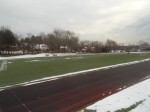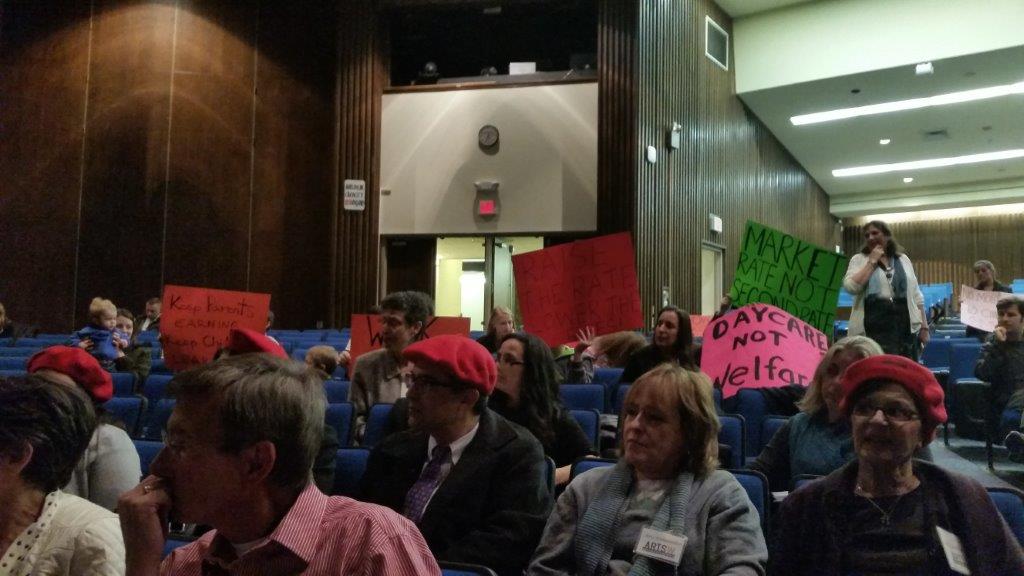P’ville Parents Group Claims Artificial Turf Isn’t Safe

A Pleasantville parents group is urging school district officials to avoid artificial turf for next year’s scheduled replacement of fields at the district’s three schools because the surface includes known or suspected carcinogens.
Parents Advocating Clean TurfGrass (PACT) formed a few months ago to fight installation of artificial turf containing crumb rubber fill. The group has launched an online petition drive, collecting signatures from more than 160 residents.
Matthew Finkelstein and Alicia Samios, parents of a kindergartener at Bedford Road School and among the leaders of the petition drive, said they have uncovered research identifying more than 30 substances found in the material, comprised of ground-up recycled tires, which is used to prop up the artificial turf grass.
Some of the substances found in crumb rubber include suspected or known carcinogens as well as heavy metals; phthalates, which can mimic estrogen once ingested into the body; and carbon black, which has been compared to asbestos in the lungs, Samios and Finkelstein said.
“Right now our school district still has time to save our children from the extra cancer risk that carbon black and crumb rubber pose,” Samios said.
Currently, there are few studies that verify the long-term results of exposure to the crumb rubber compound, but PACT members said that they want to be ahead of the game. Finkelstein argued that it took decades before health officials connected smoking or asbestos to cancer. It would be better to avoid crumb rubber than take the risk, he said.
Dr. Maida Galvez, an assistant professor of pediatrics and community and preventative medicine at Mount Sinai Hospital, said doctors are questioning whether the health risks of artificial turf have been fully assessed. She noted that anybody considering installation of a synthetic surface should research what materials are in the product.
“You have to carefully weigh the risks of potential human health effects as well as impacts on the environment versus the benefits of turf,” Galvez said. “Products should be rigorously vetted before there’s a wide-scale implementation of them.”
PACT is asking that the district consider using natural grass fields, particularly at the K-4 Bedford Road School (BRS). If that’s not possible, the district should only consider organic options for artificial turf in the bidding process.
Board of Education President Shane McGaffey said it is the trustees’ responsibility to consider bidding all types of surfaces and make an informed decision based on various factors, including price and safety.
Pleasantville Superintendent Mary Fox-Alter said grass isn’t an option at any of the schools because of heavy demand for the fields. For the fall sports season, the three schools’ fields were used for 50 hours per week, she said. That number jumps to almost 60 hours when village recreation teams are counted. The BRS field also sees high demand because it is where the district’s modified teams play and practice.
In addition, the fields are used for physical education classes and recess. Fox-Alter explained that if the district elected to use grass, some of these programs would need to be eliminated or reduced in order to give the grass time to grow properly because of the climate.
“We’re not in the South where we could grow Bermuda grass and get plenty of rain,” Fox-Alter said. “Here in the Northeast, school districts that can do a natural surface actually have multiple fields so they can let one rest, lay fallow.”
Connecticut-based Environmental Human Health, Inc. (EHHI), a nonprofit comprised of 10 physicians and public health officials, is one of the leading opponents of artificial turf and released a report on potential health risks of crumb rubber in 2007. Its president, Nancy Alderman, maintains that grass is the safest playing surface for student-athletes.
“If they would just spend a quarter of the money that the more than $1 million synthetic turf field costs on a really first-rate grass field, they would have a good field and a safe field,” said Alderman.
McGaffey said while the board will consider the health impact of all materials, it also needs to look at injury rates, which he noted have been greatly reduced since the school switched from grass to crumb rubber turf more than a decade ago.
Even if it was feasible to use natural grass fields, Fox-Alter said it would be too costly. Another staff member would be needed to manage buildings and grounds, and the district would have to install an irrigation system and purchase sod, because grass seeds wouldn’t have time to set with the amount of activity.
There is, however, no definitive scientific link between crumb rubber and cancer as of yet, and artificial turf fields are considered safe to use by a variety of government agencies.
Finkelstein and parent Linda Kluge noted that crumb rubber particles stick to everything, from clothing to balls used on the field. The biggest concern PACT members have, however, is that when children are running or diving on the fields, particles are kicked up and can be ingested into the mouth and lungs.
Fox-Alter said that since the artificial turf fields were initially installed 12 years ago, she hasn’t heard any complaints about the particles. The only comments she has received recently are from people who want to see the aging fields replaced.
Galvez said the long-term health and environmental impacts of crumb rubber turf must be assessed before doctors can definitively determine if it is unsafe for use by children. She noted that natural grass is always worth considering, but it is premature to conclude that artificial surfaces are a health risk without more research.
“Access to sports fields is very important for people of all ages. We want to encourage people to get out and be active and we also want them to be in healthy environments,” Galvez said.
If crumb rubber turf is utilized, Galvez said hand-washing stations should be provided and shoes worn on the field should be removed before going indoors. She said as of now, the main concern doctors have with artificial turf is heat, where temperatures on the surface can rise to more than 120 degrees. Galvez said she has known children to have been scalded running onto the field barefoot.
Fox-Alter said the district is currently awaiting approval from the state Education Department to begin the bidding process. Officials are in the stage of gathering information on the various types of fills that can be used for the artificial turf. She noted that in April, a month before the vote, the board presented the proposed project to the public. Several different choices for fill, including crumb rubber and natural options, were discussed.
“People are jumping to a conclusion that that means they’re going to pick [crumb rubber] and nothing can be more inaccurate than that statement,” Fox-Alter said.
She explained that all fill options are still on the table and the project was always slated to use some type of artificial turf. District officials held several community forums last year and published a brochure explaining the scope of the project to residents before the vote, noting that the new fields would be synthetic and that grass was not being considered.
The Board of Education will hold a facilities meeting Jan. 27, where the project will be discussed.

Examiner Media – Keeping you informed with professionally-reported local news, features, and sports coverage.

